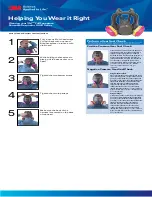
Inspection, Cleaning and
Storage Procedures for
3M Reusable Respirators
Inspection
3M
TM
6000 and 7000 Series
Respirators must be inspected
before each use to ensure good
operating condition. The facepiece
must be repaired or replaced if
there are damaged or defective
parts. The following inspection
procedure is suggested:
1. Check facepiece for cracks, tears
and dirt. Be certain facepiece,
especially faceseal area, is not
distorted.
2. Examine inhalation valves for
signs of distortion, cracking or
tearing.
3. Make sure that head straps are
intact and have good elasticity.
4. Examine all plastic parts for
signs of cracking or fatiguing.
Make sure filter gaskets or seal
areas are in good condition.
5. Remove exhalation valve cover
and examine exhalation valve and
valve seat for signs of dirt,
distortion, cracking or tearing.
Replace exhalation valve cover.
6. Inspect lens of full facepiece for
any damage that may impair
respirator performance or vision.
Cleaning and Storage
Cleaning is recommended after
each use. 3M
TM
Respirator
Cleaning Wipes 504 may be used
as an interim method in the cleaning
schedule for individually assigned
respirators, but they must not be the
only method in place. During fit-
testing, wipes may also be used
between employees being tested.
However, these respirators must be
thoroughly cleaned at the end of
each day, using procedures in
appendix B-2 of 29 CFR 1910.134.
1. Remove cartridges and filters.
2. Clean facepiece (excluding
filters and cartridges) by
immersing in warm cleaning
solution, water temperature not to
exceed 120º F (49º C), and scrub
with soft brush until clean. Add
neutral detergent if necessary. Do
not use cleaners containing lanolin
or other oils.
3. Disinfect facepiece by soaking
in a solution of quaternary
ammonia disinfectant or sodium
hypochlorite (1 oz [30 ML]
household bleach in 2 gallons [7.5
L] of water), or other disinfectant.
4. Rinse in fresh, warm water and
air dry in noncontaminated
atmosphere.
5. Respirator components must be
inspected prior to each use. A
respirator with any damaged or
deteriorated components must be
repaired or discarded.
6. The cleaned respirator should
be stored away from contaminated
areas when not in use.
NOTE: The above information
is also outlined in the users
instructions. Additionally, see
specific product user instructions
packaged with each respirator
facepiece for additional
information.
3
Technical Data Bulletin
#150, September, 2001 — Reusable Respirators
4058
Issue Date 11/01/01
WARNING
Do not clean with solvents.
Cleaning with solvents may
degrade some respirator
components and reduce
respirator effectiveness.
Inspect all respirator
components before each
use to ensure good
operating condition. Failure
to do so may result
in sickness or death.












